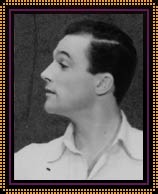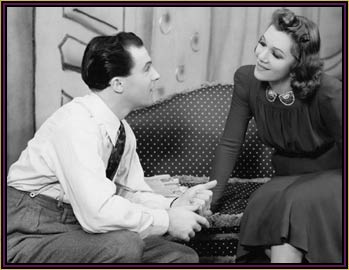 This buoyant American film star of the 1940s and ’50s was a renowned dancer-choreographer, the embodiment of proletariat good-guy cheer, and a key figure in shaping the golden age of the Hollywood musical.
This buoyant American film star of the 1940s and ’50s was a renowned dancer-choreographer, the embodiment of proletariat good-guy cheer, and a key figure in shaping the golden age of the Hollywood musical.
Born and raised in Pittsburgh, Kelly was the son of a theatrical manager and an actress. He and his brother Fred performed a dance act for the 1934 Chicago World’s Fair. After an unsuccessful screen test for RKO in 1935, Kelly turned to stage work, making his Broadway debut in the chorus of “Leave It to Me” in 1938. After a dramatic turn in William Saroyan’s “The Time of Your Life” (1939), he scored his biggest stage triumph as Joey Evans, the antihero of the Rodgers and Hart/John O’Hara musical “Pal Joey.” The latter caught the attention of film producer David O. Selznick, who signed Kelly to a seven-year contract.
Selznick immediately loaned his new star to MGM for Busby Berkeley’s FOR ME AND MY GAL (1942), a musical romp about a vaudeville couple (Kelly and Judy Garland) determined to play the Palace Theater. Kelly’s star was on the ascendant and MGM bought out his contract with Selznick. He was cast in the all-male THE CROSS OF LORRAINE as a prisoner of war. In 1944, Kelly added choreographer to his resume when he created the dance sequence for the “Alter Ego” number in the stylish COVER GIRL, in which he was a Brooklyn club owner romancing an up-and-coming actress-model (Rita Hayworth). This marked the beginning of a long string of MGM musicals that starred Kelly, including 1945’s ANCHORS AWEIGH (notable for the sequence in which Kelly dances with cartoon mouse Jerry of TOM AND JERRY fame), and two directed by Vincente Minnelli, ZIEGFELD FOLLIES (1946), in which he dances “The Babbitt and the Bromide,” which had been popularized onstage by Adele and Fred Astaire, and THE PIRATE (1948), which reteamed him with Garland and featured a lively Cole Porter score, including Kelly’s tours de force, “Nina” and “Be a Clown.”

Kelly and Vivienne Segal in the original production of Rodgers and Hart's "Pal Joey."
Kelly branched out into directing with ON THE TOWN (1949), which he co-helmed with Stanley Donen. Adapted from the Leonard Bernstein-Betty Comden-Adolph Green Broadway hit, ON THE TOWN followed the adventures of three sailors (Kelly, Frank Sinatra, and Jules Munshin) on leave for one day in New York City and the women (Ann Miller, Vera-Ellen, and Betty Garrett) they encounter. Kelly and Sinatra reteamed for Busby Berkeley’s TAKE ME OUT TO THE BALL GAME (also 1949), as turn-of-the-century ballplayers coping with a new female owner (Esther Williams). Kelly and Donen co-directed the “Strictly USA” segment and received an overall story credit. But it was the Oscar-winning AN AMERICAN IN PARIS that marked Kelly’s artistic triumph. Directed by Vincente Minnelli and written by Alan Jay Lerner, the musical was an original story that interpolated a lushly arranged Gershwin score. While the plot was fairly standard (American man, Kelly, torn between wealthy Nina Foch and gamine dancer Leslie Caron), the staging was imaginative, including a spectacular 18-minute ballet sequence that still ranks as one of the best ever filmed. The film won a total of eight Oscars as well as a special award for Kelly, citing his “brilliant achievements in the art of choreography on film.”
Kelly was the son of a theatrical manager and an actress.
Gene Kelly
Born: August 23, 1912
Died: February 22, 1996
Key Shows
- "Best Foot Forward"
- "Flower Drum Song"
- "Leave It to Me!"
- "Pal Joey"
Related Artists
- George Abbott
- Fred and Adele Astaire
- Oscar Hammerstein II
- Lorenz Hart
- Mary Martin
- Cole Porter
- Richard Rodgers
Kelly followed with what many consider to be the greatest film musical — SINGIN’ IN THE RAIN (1952). Set in the 1920s, just as talking films are being introduced, the film follows the romance of silent screen star Kelly and newcomer Debbie Reynolds. Featuring the rubbery Donald O’Connor and an uproarious Jean Hagen, the film contains some of the movie musical’s best-remembered sequences, including his signature routine to the title song and the “Broadway Rhythm” ballet. Throughout the ’50s, Kelly continued to appear in musicals (e.g., BRIGADOON, 1954 and the underrated IT’S ALWAYS FAIR WEATHER, 1955) but most were forgettable. An attempt to make a strictly dance film, INVITATION TO THE DANCE (1956), which Kelly wrote, directed, choreographed, and starred in, received mixed reviews; most cited the final “Sinbad the Sailor” sequence as the most successful as it displayed the novel mixing of live action and cartoons. Increasingly from the late ’50s, Kelly began to play nonmusical roles, notably as a skeptical reporter in Stanley Kramer’s INHERIT THE WIND (1960). He also worked more behind the camera, helming such diverse fare as THE HAPPY ROAD (1956), A GUIDE FOR THE MARRIED MAN (1967), and the overblown version of HELLO, DOLLY! (1969). Throughout the ’70s and ’80s, Kelly worked less frequently, often as host or narrator of TV specials or compilation films (THAT’S ENTERTAINMENT!, 1974, its two sequels from 1976 and 1994, and their companion piece, THAT’S DANCING!, 1985). His last major onscreen appearance was in the poorly executed XANADU (1980). He worked as an uncredited supervisor of the musical sequences in Francis Ford Coppola’s misbegotten ONE FROM THE HEART (1982). Kelly’s final screen appearance was as host of a segment of THAT’S ENTERTAINMENT! III (1994).
When film dancers are considered, two usually come to mind: Astaire and Kelly. Astaire represented refinement; Kelly, athleticism. Kelly was a swaggeringly virile dancer of incomparable grace and charm. He pushed the boundaries of film dancing beyond the established limits, particularly with AN AMERICAN IN PARIS and INVITATION TO THE DANCE.
Source: Excerpted from Baseline. BaselineStudioSystems — A Hollywood Media Corp. Company.
Photo credits: Photofest and Culver Pictures
 This buoyant American film star of the 1940s and ’50s was a renowned dancer-choreographer, the embodiment of proletariat good-guy cheer, and a key figure in shaping the golden age of the Hollywood musical.
This buoyant American film star of the 1940s and ’50s was a renowned dancer-choreographer, the embodiment of proletariat good-guy cheer, and a key figure in shaping the golden age of the Hollywood musical.

